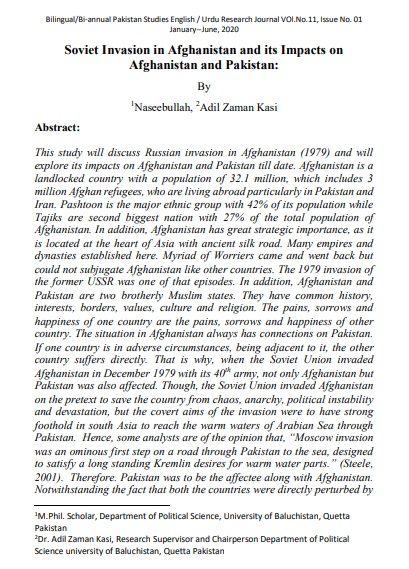Soviet Invasion in Afghanistan and its Impacts on Afghanistan and Pakistan:
Keywords:
Soviet invasion, Implication for Pakistan and Afghanistan, Drug trafficking, Kalashnikov culture, Anarchy, economic dwindling.Abstract
This study will discuss Russian invasion in Afghanistan (1979) and will
explore its impacts on Afghanistan and Pakistan till date. Afghanistan is a
landlocked country with a population of 32.1 million, which includes 3
million Afghan refugees, who are living abroad particularly in Pakistan and
Iran. Pashtoon is the major ethnic group with 42% of its population while
Tajiks are second biggest nation with 27% of the total population of
Afghanistan. In addition, Afghanistan has great strategic importance, as it
is located at the heart of Asia with ancient silk road. Many empires and
dynasties established here. Myriad of Worriers came and went back but
could not subjugate Afghanistan like other countries. The 1979 invasion of
the former USSR was one of that episodes. In addition, Afghanistan and
Pakistan are two brotherly Muslim states. They have common history,
interests, borders, values, culture and religion. The pains, sorrows and
happiness of one country are the pains, sorrows and happiness of other
country. The situation in Afghanistan always has connections on Pakistan.
If one country is in adverse circumstances, being adjacent to it, the other
country suffers directly. That is why, when the Soviet Union invaded
Afghanistan in December 1979 with its 40th army, not only Afghanistan but
Pakistan was also affected. Though, the Soviet Union invaded Afghanistan
on the pretext to save the country from chaos, anarchy, political instability
and devastation, but the covert aims of the invasion were to have strong
foothold in south Asia to reach the warm waters of Arabian Sea through
Pakistan. Hence, some analysts are of the opinion that, “Moscow invasion
was an ominous first step on a road through Pakistan to the sea, designed
to satisfy a long standing Kremlin desires for warm water parts.” (Steele,
2001). Therefore. Pakistan was to be the affectee along with Afghanistan.
Notwithstanding the fact that both the countries were directly perturbed by the brutal invasion of the Soviet Union. Unfortunately, the USA and its
Western allies including Saudi Arabia left both Afghanistan and Pakistan
in a lurch after the Soviet withdrawal. They did not make any roadmap and
planning for the future and socio-economic developments of both states.
This study will shed light on the soviet invasion in Afghanistan and its socio,
economic political, and other impacts on Afghanistan and Pakistan.
References
Amin, Shaikal. (20014). “Modern Afghanistan: A history of struggle and
survival.” I. B, Tauris publisher New York. P 127.
Amin, Shaikal. (1998). “Afghan ethnic conflict, survival.”. P118
Christopher, Thamous. (1997). “Taliban routs ends Islamabad’s dream”.
The Herald.
Chainland, Greyer. (1982), “Reports from Afghanistan.” Penguin books ltd
NY. P2
Daily, Dawn, 3 August 2003
Economic survey of Pakistan 2017-18
Hussain, Naveed. (2016). “Global coalition to protect education from
attacks.” Express tribune 24 February 2016.
Indian consulates in Afghanistan behind terror in Baluchistan: The daily
times 3 April 2016
Jalazai, Musa Khan. (2003). “The political economy of Afghanistan.” Sangi-meel publisher Lahore.P73
Jalazai, Musa khan. (1995). “Sectarianism and ethnic violence in
Afghanistan.” Vanguard books limited Karachi.P146-7
Karim. Muhammad, (2017).” Worlds power rivalry and its impacts on
Pakistan.” The dialogue. Qurtaba university press, JulySep. P247
Khan, Riaz Muhammad. (2017). “Pakistan and Afghanistan.” Alfa
publisher Lahore. P111
Lamb, Christina. (2004). “Taliban’s Afghanistan.” Translated by
Muhammad Yehya Khan. Nigarishat publisher Lahore. P5
Musharraf, Pervez. (2006). “In the line of fire.” Simmon and Schuster
publisher UK Ltd London (2006). P222
Pravda 25 June 1990. www.prevda.com
Rashid. Ahmed (2008). “Decent into chaos.” Penguin group London. P323
Rafiqi, Abdul Rauf Dr. (2019, 22, September.)
Rashid, Ahmed. (200), “Taliban: militant Islam, oil and feudalism in
central Asia.” I. B. Tauris and co. ltd London. CBR official 1996-7-
-9. P191
Steel, Jonathan, (2011). “Ghosts of Afghanistan: haunted battleground.”
Portobello books London. P 64
Steel, Jonathan. (2011). “Ghosts of Afghanistan: The haunted
battleground.” Portobello books London. P 242
Sheikh, Salim Assad. (1981), “Afghan immigrants.” a revive. P146
Shahid, Muhammad, Imtiaz, (2017), “Contemporary affairs. American
nightmare in Afghanistan” By Servat, Hanif. Advanced publisher
Lahore.P131
Salim, Ali. (2012), “Islam and education: conflict and conformity in
Pakistani Madrassas.”. Oxford university press Karachi.P39-46
UNDP, Report. www.undp.org.com
UN charter. www.UN.orgedudocument.
World Global Terrorism index 2018
Wikipedia.
Weitz, Richard, (2016), “Global insight: As US draws drown, India
raises security profiles in Afghanistan. Global political rivalry”



